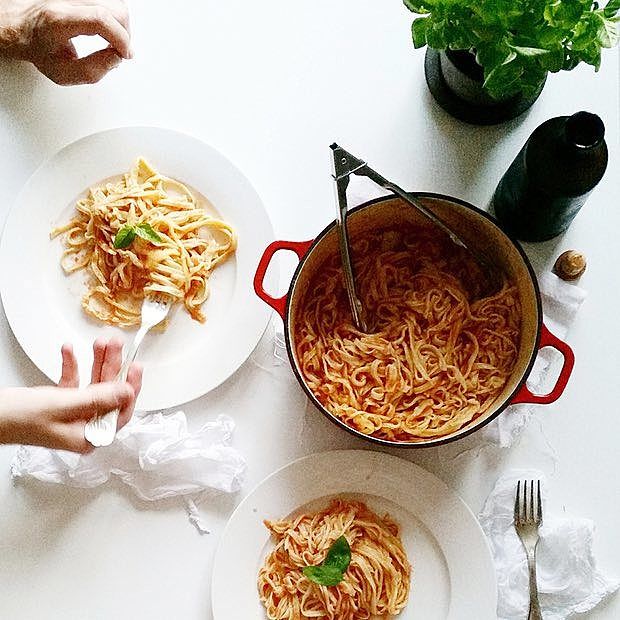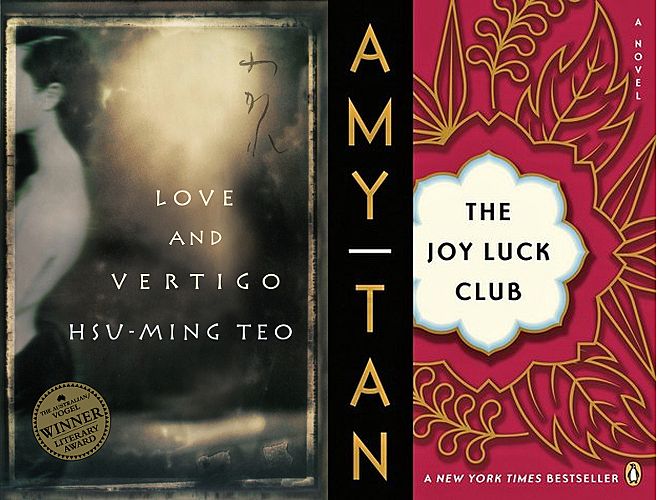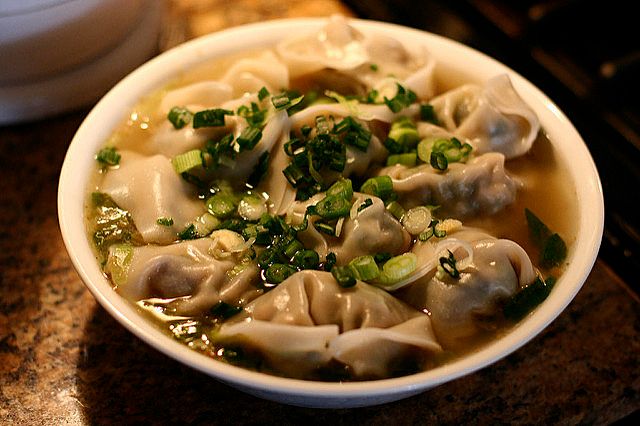Shiny Red Apple: Food in Fiction
Karen Tay explores the role of food in fiction, from the way it can evoke comfort to more problematic depictions of food that reinforce cultural stereotypes
The shiny red apple in the fairy tale Snow White could be a metaphor for the role of food in fiction; it sometimes looks good enough to eat, but there is a chance it may be poisonous. In this essay, Karen Tay explores the portrayal of food in fiction, from the way it can evoke comfort or let a reader into the lives of others, to more problematic depictions of food that reinforce cultural stereotypes.
The small pretty child lifted up her spoon, and smeared thick white congee, salted duck egg and dried anchovies into her mouth, leaving behind a white moustache. I read this scene in a book just after high school and the words, dimmed and wrought inexact now by memory, stayed with me over the years – through lifetimes and loves lost and gained, through shifts from one end of the city to the other – as I looped my way through Auckland’s cultural boroughs, switched jobs, swapped vodka for wine and greasy house parties for nights in with the cat, the image of that unwanted girl, her cheeks smudged with salted-egg yolk, stayed in my mind’s eye.
The girl was called Pandora. She was the mother of the main character in the debut novel Love and Vertigo by Australian author and academic Hsu Ming Teo. The story is about a young Australian émigré growing up in the land of Waltzing Matilda, and her Singaporean family’s struggle to fit in with white Australia. The flavours of my childhood permeated the pages of Teo’s book, from soft boiled eggs with golden yolks dribbled with soy sauce and dusted with pepper, to the sting of fresh cut chillies and sambals over fried noodles, and the fresh perfume of a green pandan cake. My relationship to these foods made it hard to forget the little girl, dressed in her silk samfoo, frozen in prose.
We all eat, and food can take a reader to a time and place. It’s a way to set tone, so it may be exotic or humdrum depending on what you’re trying to achieve. The absence of food can also be very evocative.
We look for versions of ourselves in fiction, perhaps most obviously through food and the ritual of eating. Food in fiction has been a favourite literary device of writers since the beginning of storytelling itself, from Hansel & Gretel’s trail of breadcrumbs to the shiny red apple in Snow White, and the famous folk tale about Stone Soup; food, feasting and eating have been used as metaphors for sensuality and sexuality, love, grief, loss, redemption and above all, the collective human experience. ‘I think it’s the universality,’ says New Zealand author Nicky Pellegrino of food in literature. Her own contemporary novels are famed for their descriptions of Italian food. She goes on to say: ‘We all eat, and food can take a reader to a time and place. It’s a way to set tone, so it may be exotic or humdrum depending on what you’re trying to achieve. The absence of food can also be very evocative.’
If the ingestion of food is one thread that binds humanity, then the cultural and geographic differences between food can be seen as a wall that separates us – it can be breached, but only with conscious effort and determination. Writers often write what they know, but this knowledge is only familiar to those of the same culture and background, and therefore foreign to others.
There are the dishes and ingredients that become famous cultural signifiers, comforting and exotic all at once: fried green tomatoes at the Whistle Stop Cafe evokes the claustrophobic and segregated old American South in Fannie Flagg’s novel; cut green mango dipped in chilli and salt symbolises a carefree, sun-drenched colonial Sri Lankan childhood in Karen Roberts’ Flower Boy; the apparently British comfort feasts of ‘lashings’ of ginger beer, hard-boiled eggs and jam tarts that sustain the Famous Five in Enid Blyton’s books; Salman Rushdie’s Midnight’s Children, with its pickles and chutneys, kasundis and curries, an apt allegory for post-colonialism; and closer to home the eel, crays, puha and pork that introduce readers both to traditional kai and the disenfranchisement of urban Māori in Patricia Grace’s novels.
But while food can soothe like nothing else, and despite the best of intentions of the writer, food in literature can also reveal the oppression and stereotypes that exist within different cultures, or as some would argue, the writer’s perceptions of those cultures, and can ‘other’ a culture through exoticism. The critically acclaimed Midnight’s Children, for example, depicts the Indian female characters as not having a voice within their society, which was in transition to independence from British rule. In one scene, the character Amina, who has acquiesced to her parent’s demands to marry a man she does not love, experiences food as the way the women in the family communicate how they really feel:
And now, restored to the status of daughter in her own home, Amina began to feel the emotions of other people's food seeping into her – because Reverend Mother doled out the curries and meatballs of intransigence, dishes imbued with the personality of their creator; Amina ate the fish salans of stubbornness and the birianis of determination. And, although Mary's pickles had a partially counteractive effect – since she had stirred into them the guilt of her heart, and the fear of discovery, so that, good as they tasted, they had the power of making those who ate them subject to nameless uncertainties and dreams of accusing fingers – the diet provided by Reverend Mother filled Amina with a kind of rage, and even produced slight signs of improvements in her defeated husband.
In Midnight’s Children food becomes the vehicle through which Rushdie’s women are allowed to express themselves; the ‘Reverend Mother’ shows her displeasure through her ‘meatballs,’ and the servant Mary expressed her ‘guilt’ through her ‘pickles.’ In essence, food is used to show the struggle women had at that time to have any kind of voice.
Reading about strange and unfamiliar food can be exciting precisely because eating such food is outside of the reader’s typical experience. To make sense of the world the human mind invariably tends towards stereotype, but even positive associations between a culture and certain foods can lead to the unsavoury effect of objectifying that culture. For instance, Japanese author Haruki Murakami’s obsession with fast food has him describing characters getting McDonald’s, KFC, Dunkin’ Donuts and even Denny’s fried chicken salad (there are even blogs dedicated to the food in his novels). While Murakami may be expressing his own interest in food – and it has been argued that his descriptions of ‘mundane’ food ground his stories - such depictions can perpetuate the stereotype of the lazy, overweight modern Japanese young adult, addicted to American culture, fat, sugar, and the deep-fryer.
Even positive associations between a culture and certain foods can lead to the unsavoury effect of objectifying that culture.
Authors can use this type of stereotyping to speak uncomfortable truths. In Love and Vertigo, Pandora dreams of a foreign lover who will ‘sweep her off her feet’ with flowers and 16th century English Romantic poetry. Instead she becomes the girlfriend and later wife of a local Singaporean man who tries to woo her with ‘plastic bags of coconut juice’ and ‘steaming Hokkien egg noodles fried in thick black soy sauce’ and ‘two glasses of the black grass jelly drink that he didn’t know she disliked intensely because he’d never asked.’
Later in the chapter, Pandora catches a glimpse of and yearns for a ‘young Eurasian man with light brown hair…a giggling Chinese girl squirming on his lap. He had open a book of Byron’s poetry and was reading it aloud to the woman, feeding her spoonfuls of sweet yam soup in between stanzas.’ The internalised racism that can be experienced by Singaporeans (and other post-colonial societies) is laid bare in these poignant descriptions – the object of desire is a man with European heritage, and much like the unofficial caste system that still exists in much of Asia (where skin lightening creams and sun umbrellas show the desire to keep skin pale), the food that the characters consume – the ‘black grass jelly’ versus the ‘sweet yam soup’ – is also used to denote class, and class, inevitably, is based upon race.
Nowhere is the ‘food as social class’ theme more apparent than in the literature of postcolonial India and Sri Lanka. In Arundhati Roy’s The God of Small Things, which won the Man Booker prize in 1997, food is used as a marker of social strata. For example, Chacko, the uncle of the family, and former Rhodes scholar and confessed Anglophile, eats a plain western breakfast of poached eggs on toast at a cafe while studying at Oxford; his character’s ability to eat Western food shows his rise upward through the class system, and the wealth that allows him to study abroad.
The central family of the novel, however, own Paradise Pickles and Preserves, a traditional Indian condiment, and which symbolises in the book a lower class status. In The God of Small Things lower class food is associated with a lack of agency: one of the twins is sexually molested as a child by the ‘Orangedrink Lemondrink man,’ and a nameless Indian cook makes Ammu’s last meal of fried fish, before her spectacular fall from grace.
Karen Roberts’ debut novel Flower Boy, set during the final years of British rule in Ceylon, also explores the role of food in class distinctions. The missionary-schooled Sri Lankan cook and housekeeper Premawathi is praised by the British wife of the tea plantation owner for her ability to make English foods despite never having set foot on British soil, including a ‘more than passable’ traditional Christmas cake. In an interview with the Sunday Times, Roberts acknowledges the link between food and cultural identity, saying, ‘I am extremely Sri Lankan. If there’s rice and curry, I don’t care who’s there, I just dive in with my fingers.’ For the character of Premawathi, being be able to pass as a British cook allowed Premawathi social capital not just in the eyes of her employer, but also gives her a higher status within Sri Lankan society.
A gentler interpretation of the depiction of food in fiction could simply be that it is an instinctive way for writers to let readers learn more about the everyday ritual and intimacies of another culture. After all, eating is an act shared by all humans, even if what is ingested differs by region, culture, and class. Author Patricia Grace, of Ngati Toa, Ngati Raukawa and Te Ati Awa descent argues: ‘It is natural for us to want to know more about each other,’ and that ‘authors are simply describing everyday life.’ She goes on to say:
As a reader, I take as much interest in what the character eats and cooks as I would in the language used, the house a person lives in or how they earn a living. It’s all background. I think either the reader will relate to what the author has written because it is familiar, or they will be interested because it is ‘other.’
It is an opinion that is echoed by Nicky Pellegrino, who doesn’t feel that she is ‘writing books about food.’ She states:
I’m writing novels about people who cook and/or eat whilst a lot of other stuff is going on with their lives. The character in the novel I’m working on at the moment is grappling with getting older, for instance. But hey, she still has to eat!
Pellegrino mentions the character of Stella in her book Under Italian Skies as an example: ‘Food is fused with the story but is never meant to be more important than it. In that book it becomes a part of the way Stella’s life changes – it’s a vehicle for her to meet new people and experience different lives – but it’s far from the whole deal.’
Food as comfort and escapism is not a new concept. If food is nourishment, then it is also nurture – parents feed their babies blended pap, gradually introducing them to the flavours which will season their adult palates. Amy Tan and Toni Morrison both use the soul food of their culture to write about the experiences of being African-American and Chinese-American. Tan’s The Joy Luck Club has a character stuffing wontons, ‘one chopstick of gingery meat dabbed onto a thin skin and then a single fluid turn with her hand that seals the skin into the shape of a tiny nurse’s cap.’ In Morrison’s tale Beloved it is Southern comfort food that infuses the pages with a sense of nostalgia and longing – biscuits, a cup of sugar or flour, the burned bottom of bread scraped from the pan. These are the tastes and moments that leave us homesick, reaching for the dream before it vanishes.
But is food really mere background detail in fiction, and no more than a pretty confection or the icing on the cake? Literary theorist Roland Barthes explains the problem that arises from this view in his essay 'Toward a Psychosociology of Contemporary Food Consumption.' In referring to the complex French relationship with their own cuisine, he says: ‘For we do not see our own food, or worse, we assume that it is insignificant.’ Barthes goes on to state why viewing food as insignificant is an issue:
Food serves as a sign not only for themes, but also for situations….to eat is a behaviour that develops beyond its own ends, replacing, summing up and signalizing other behaviours, and it is precisely for these reasons that it is a sign...food is an organic system, organically integrated into its specific type of civilisation.
In short, for everyone, what and how we eat is governed by cultural norms and expectations, and those behaviours extend far beyond food.
So we come full circle then, to the silk-clad girl in Love and Vertigo, and the universality and specificity of food in fiction. I like to think of this complex relationship as a sort of symbiosis between two similar but not identical organisms, and that we should be mindful of that relationship and the power dynamics within. Recently I finished a book called Pachinko by Min Jin Lee, about the lives of ethnic Koreans in pre- and post-war Japan. The book describes a buffet of Korean and Japanese food – Sunja’s kimchi, wild mushrooms foraged from the forest, soup made from shinbones and oxtails, white rice and dried squid and sushi, zaru soba eaten at lunchtime.
The book left me with a little hollow fist of hunger nestled in the pit of my stomach; a craving for the flavours of the meals described. While some of the meals were familiar, and others were utterly foreign, all were seductive. It struck me that this feeling of both emptiness and fulfillment, of the familiar and the exotic, is what makes food in fiction so fascinating and eternally appealing. Like a small child turning their face towards the mother, mouth open in anticipation of the spoon.
Image Credits: Header image 'EAT' by kendrahw and used under CC-BY-NC 2.0; 'Wonton' by 松林 and used under CC-BY 2.0.






